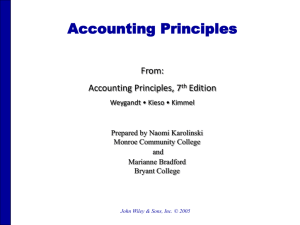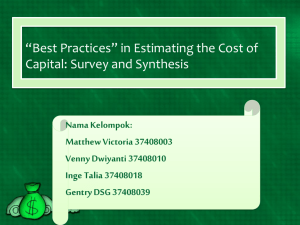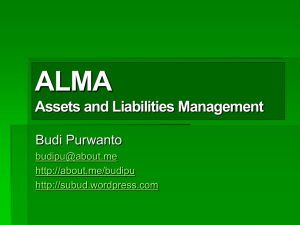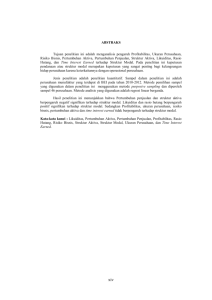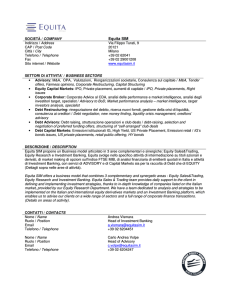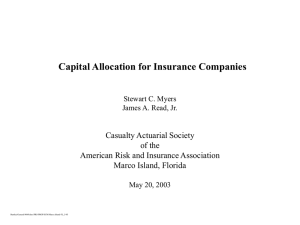SI327-092173-841-3 2690KB Apr 30 2011 01:13:37 PM
advertisement
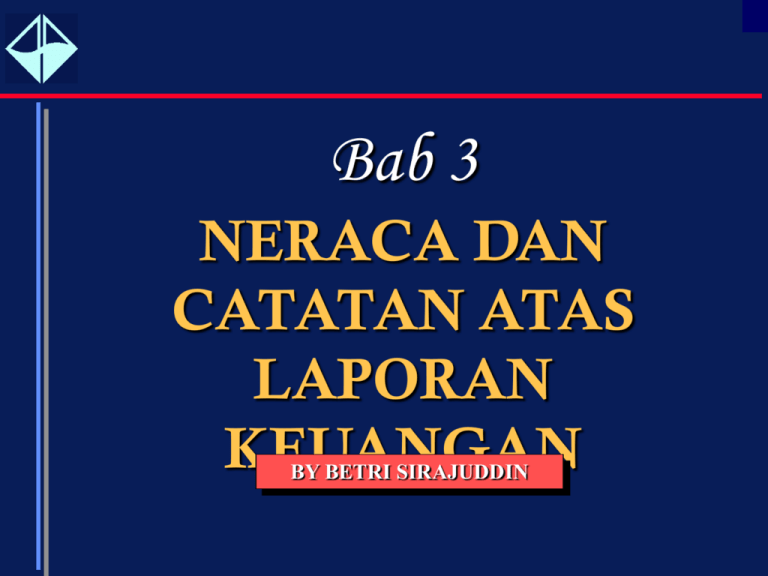
1 Bab 3 NERACA DAN CATATAN ATAS LAPORAN KEUANGAN BY BETRI SIRAJUDDIN 2 KOMPONEN NERACA Walaupun neraca menyajikan hasil dari transaksi dan kejadian masa lalu, tujuan utama neraca adalah prediksi masa depan Manfaat Ekonomi Masa Depan 3 KOMPONEN NERACA Bentuk harta dalam neraca seperti kas, perlengkapan, piutang, tanah, bangunan dan peralatan. 4 KOMPONEN NERACA “Obligasi” mencakup komitmen legal, moral, sosial dan kewajiban yang tersirat Kewajiban Liability Kemungkinan pengorbanan manfaat ekonomi di masa depan yang timbul dari kewajiban sekarang dari suatu entitas untuk mengalihkan aktiva atau menyediakan jasa kepada entitas lain pada masa yang akan datang sebagai hasil dari transaksi atau kejadian di masa lalu 5 KOMPONEN NERACA Kewajiban terdiri dari utang yang jumlahnya diukur dengan satuan uang seperti utang usaha dan utang jangka panjang 6 KOMPONEN NERACA Ekuitas Sisa kepemillikan atas aktiva dari suatu entitas setelah dikurangi kewajibankewajibannya. Modal disetor Saham Biasa Laba ditahan KLASIFIKASI NERACA Aktiva lancar (kurang dari 1 tahun) Aktiva tidak lancar (lebih dari 1 tahun) Kewajiban lancar Kewajiban tidak lancar Ekuitas Pemilik 7 8 Modal Kerja Modal kerja adalah selisih antara aktiva lancar dan kewajiban lancar. Adalah cadangan likuid yang tersedia untuk memenuhi kebutuhan keuangan masa depan 9 Aktiva lancar Aktiva lancar yang umum adalah kas, piutang dan persediaan. Siklus operasi yang normal berlangsung lebih dari satu tahun dalam praktek periode satu tahun. • • • • KasCash Piutang Perlengkapan Aktiva lancar lain 10 Siklus Operasi Kas Penagihan Pembelian Persediaan Piutang Penjualan 11 Aktiva Tidak Lancar • Investasi • Properti • Pabrik & peralatan • Aktiva pajak penghasilan tangguhan 12 Properti, Pabrik dan Peralatan Properti, Pabrik dan Peralatan adalah properti berwujud dan relatif permanen dan umum digunakan dalam operasi bisnis yang normal 13 Harta Tidak Berwujud Harta tidak berwujud adalah hak jangka panjang yang diperoleh perusahaan yang tidak berbentuk fisik dan digunakan dalam operasi perusahaan 14 Kewajiban Lancar Secara umum Current liabilities jika are suatu obligations kewajiban expected to dapat diharapkan be paid dibayar using dalam currentwaktu assets12 or by creating bulan maka diklasifikasikan other current liabilities. sebagai kewajiban lancar • Utang usaha dan wesel bayar • Beban yang harus dibayar • Bagian lancar kewajiban jangka panjang • Kewajiban lancar lain 15 Kewajiban yang dapat Ditarik Kewajiban yang harus dibayar sesuai dengan keinginan kreditor dan tidak ada tanggal jatuh tempo yang jelas. 16 Kewajiban Tidak Lancar Kewajiban yang tidak diharapkan akan dibayar dalam 12 bulan. Dikelompokan seperti utang jangka panjang, kewajiban sewa jangka panjang, kewajiban pajak penghasilan tangguhan dan kewajian tidak lancar lainnya 17 Kewajiban Tidak Lancar Hutang jangka panjang (Long-term debt) disajikan pada nilai sekarang yang didiskontokan 18 Contingent Liabilities Aktivitas atau kondisi masa lalu dapat menimbulkan kemungkinan terjadinya utang masa depan walaupun kewajiban tersebut tidak terdapat pada tanggal neraca. Kemungkinan adanya klaim .. 19 Contingent Liabilities Berbeda dengan kewajiban estimasi. Yang sudah jelas, hanya jumahnya yang masih dipertanyaan. Ekuitas Pemilik (Owners’ Equity) Contributed Capital: Capital stock Additional paid-in capital 20 Owners’ Equity Capital stock usually is Contributed Capital: the number of shares Capital stock issued multiplied by the par or stated value. Additional paid-in capital 21 Owners’ Equity Contributed Capital: The two types of capital stock are Capital stock preferred and Additional paid-in capital common. 22 Owners’ Equity Additional paid-in Contributed Capital: capital is the excess Capital stock invested above par or stated value of the Additional paid-in capital capital stock. 23 Owners’ Equity Retained earnings is the amount of undistributed earnings of past periods. 24 Large Retained Earnings Balances for the Year 2000 Company Name Exxon Mobil General Electric Citigroup PSINet Nextel Excite@Home Retained Earnings $81,463,000,000 59,072,000,000 58,116,000,000 –5,894,000,000 –6,554,000,000 –9,125,000,000 25 26 Other Equity X Corporation Common Stock Par $10 When a company buys back its own shares, the repurchased shares are called treasury stock. 27 Other Equity X Corporation Common Stock Par $10 Treasury shares can be retired, or they can be retained and reissued later. 28 Other Equity The FASB requires Unrealized gainsSome and of the unrealized companies to losses on availablegains and losses from from summarizeAdjustments changes arising for-sale securities theare fluctuations in the the change in the equity of in owners’ equity value of (as derivatives are shown as a subsidiaries separate foreign exclusive of net reported equity item. measured in U.S. dollars)as part of income and accumulated resulting from changes in other contributions by and currency comprehensive income. foreign distributions to rates are shown exchange owners.in the equity section. 29 Format of the Balance Sheet Generally, assets and liabilities are presented in their order of liquidity. Some industries with significant investments in land and buildings will list these items first on the balance sheet. Generally, a balance sheet is presented in comparative form, including data from both the current year and the previous year. 30 Format of the Balance Sheet Foreign Foreignbalance balancesheets sheetsare frequently presented list the current with property, assets andplant current and equipment liabilities listed together. first. 31 Evaluating Liquidity Current Ratio: current assets divided by current liabilities Quick Ratio: quick assets divided by current liabilities (Acid-Test Ratio) 32 Liquidity Ratios Example Cash Net Accounts Receivable Current Ratio Inventory Current Assets Current Liabilities Current Assets $200 Current$100 Liabilities $ 30 70 100 $200 100 = 2:1 33 Liquidity Ratios Example Cash Net Accounts Receivable Inventory Quick Ratio Current Assets Current Liabilities $100 Quick Assets Current$100 Liabilities $ 30 70 100 $200 100 = 1:1 34 Current Ratio McDonald’s 0.8 Microsoft 3.6 Disney 1.1 Coca-Cola 0.9 Ebay 4.9 35 Overall Leverage Debt Ratio: total liabilities divided by total assets. Total Assets $400 Total Liabilities 300 Total $300 Liabilities $400 Total Assets = 75% 36 Debt Ratio McDonald’s 57.9% Microsoft 20.2% Disney 48.1% Coca-Cola 49.3% Ebay 14.9% 37 Asset Mix The percentage of total assets in each asset category. Property, Plant, and Equipment Total Assets Property, Plant, and Equipment $50 Total Assets $400 $ 50 400 = 12.5% 38 Asset Mix—PP&E McDonald’s Microsoft 76.7% 3.9% Disney 29.5% Coca-Cola 19.9% Ebay 8.5% 39 Efficiency “Asset Turnover” is a financial ratio measuring how efficiently a company uses its assets to generate sales. Sales $200 Total Assets 400 Sales $200 Total $400 Assets = 0.50 40 Asset Turnover McDonald’s 0.66 Microsoft 0.43 Disney 0.58 Coca-Cola 0.90 Ebay 0.45 41 Overall Profitability Two ratios that measure overall profitability are “Return on Assets” and “Return on Equity.” Return on Assets Net Income Total Assets Stockholders’ Equity Net $40 Income Total Assets $400 $ 40 400 160 = 10.0% 42 Return on Assets McDonald’s 7.3% Microsoft 12.4% Disney –4.0% Coca-Cola 17.7% Ebay 5.4% 43 Overall Profitability Two ratios that measure overall profitability are “Return on Assets” and “Return on Equity.” Return on Equity Net Income Total Assets Stockholders’ Equity Net $40 Income Stockholders’ $160 Equity $ 40 400 160 = 0.25% 44 Return on Equity McDonald’s 17.3% Microsoft 15.5% Disney Coca-Cola Ebay –.7% 34.9% 6.3% 45 Notes to Financial Statements • Summary of significant accounting policies. • Additional information to support summary totals. • Information about items not included in financial statements. • Supplementary information required by the FASB or the SEC to fulfill the full-disclosure principle. 46 Subsequent Events Balance Sheet Date Financial Statement Period Date Statements Issued Subsequent Period Events in this period may affect the reporting of events in this period. 47 Subsequent Events Balance Sheet Date Financial Statement Period Date Statements Issued Subsequent Period •Types of Events •Ones that materially affect one or more financial • statements. •Ones that create a need for a footnote. 48 Limitations of the Balance Sheet Does not disclose actual value of the entity. Does not disclose effects of inflation. Classifications are not uniform among companies. Does not disclose all assets and liabilities. 49 chapter 3 The End

